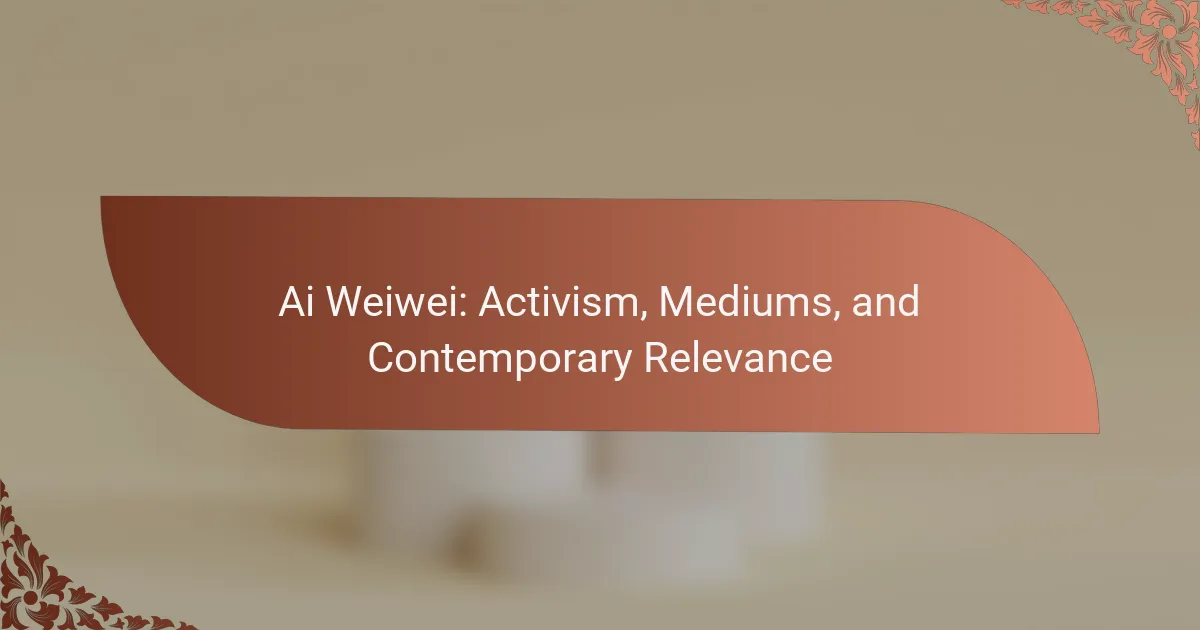Ai Weiwei’s art serves as a powerful form of activism against political oppression and human rights violations. This article explores his diverse mediums, including installation and photography, and highlights key exhibitions that showcase his impactful work. It also examines the challenges he faces in his activism and how his unique approach resonates with global audiences today.
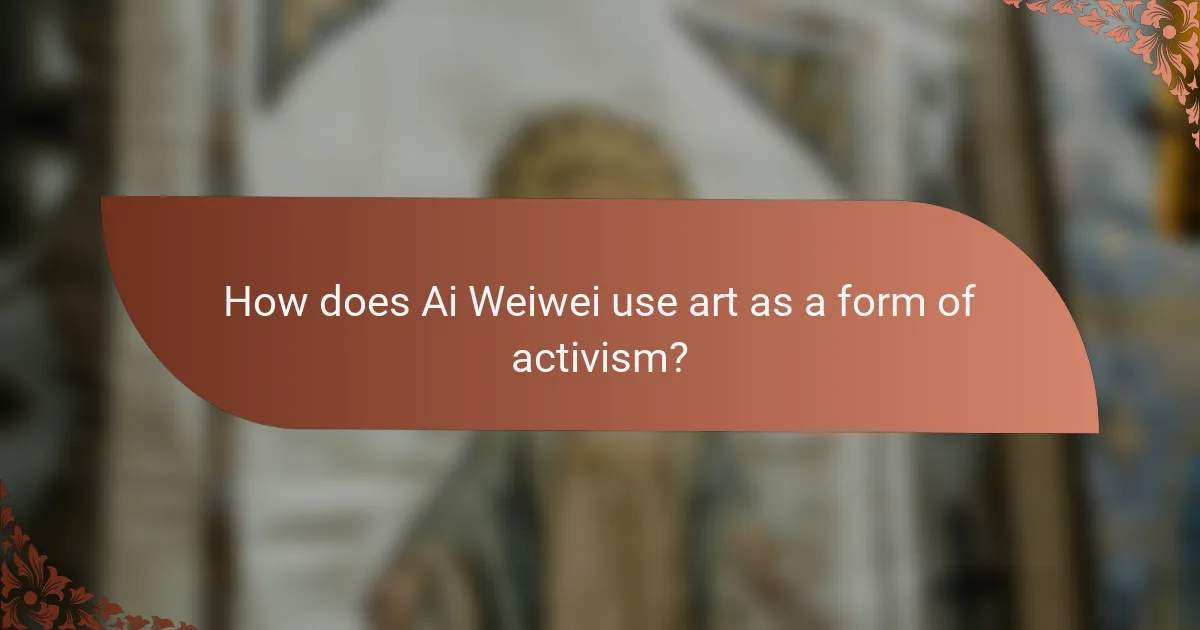
How does Ai Weiwei use art as a form of activism?
Ai Weiwei uses art as activism to challenge political oppression and promote human rights. His works often address social issues, utilizing mediums like installation, sculpture, and photography. For example, the “Sunflower Seeds” installation critiques mass production and consumerism, while “Remembering” honors victims of the Sichuan earthquake. Ai’s unique approach combines aesthetic appeal with poignant messages, making his art a powerful tool for raising awareness and inspiring change. His contemporary relevance lies in his ability to engage audiences globally, fostering dialogue around critical issues.
What are the key themes in Ai Weiwei’s activist art?
Ai Weiwei’s activist art emphasizes themes of human rights, freedom of expression, and social justice. His work often critiques government oppression and advocates for marginalized communities. Notable mediums include sculpture, installation, and social media, enhancing contemporary relevance. His unique approach blends traditional Chinese art with modern techniques, creating a powerful dialogue on global issues.
How does Ai Weiwei’s background influence his artistic activism?
Ai Weiwei’s background deeply influences his artistic activism through personal experiences and cultural heritage. His early life in China during the Cultural Revolution shaped his views on freedom and expression. This historical context drives his critique of government oppression and human rights abuses.
Ai Weiwei’s unique attributes include his use of diverse mediums, such as sculpture, installation, and social media, to amplify his messages. His works often reflect themes of displacement and resilience, resonating with global audiences. As a result, he remains a prominent figure in contemporary art and activism, bridging cultural gaps and inspiring change.
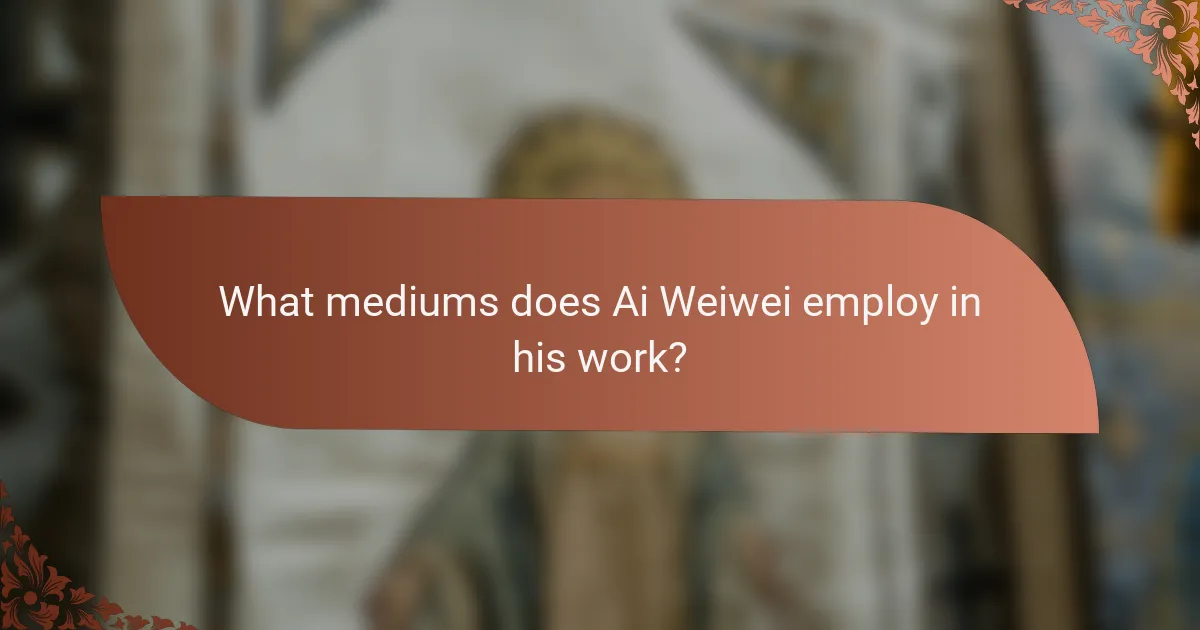
What mediums does Ai Weiwei employ in his work?
Ai Weiwei employs various mediums including sculpture, installation, photography, and film. His work often combines traditional techniques with contemporary materials. Notably, he uses social media to amplify his activism. His unique approach integrates political commentary with artistic expression, making his art relevant in today’s societal context.
How does Ai Weiwei incorporate traditional Chinese art forms?
Ai Weiwei incorporates traditional Chinese art forms through innovative mediums, blending cultural heritage with contemporary issues. He utilizes techniques like porcelain craftsmanship and calligraphy, reinterpreting them in modern contexts. For instance, his installation “Sunflower Seeds” uses traditional porcelain methods to comment on mass production and individuality. Additionally, Ai’s work often reflects themes of social activism, challenging political norms while honoring historical practices. This fusion emphasizes the relevance of traditional art in addressing current societal challenges.
What role does digital media play in Ai Weiwei’s projects?
Digital media plays a crucial role in Ai Weiwei’s projects by amplifying his activism and reaching global audiences. Through platforms like social media, he shares his art and messages, fostering dialogue on human rights and freedom of expression. His unique approach combines traditional art forms with digital tools, creating immersive experiences that challenge societal norms. Additionally, digital media allows for real-time engagement, enabling viewers to interact with his work and participate in activism. This integration enhances the impact and relevance of his projects in contemporary society.
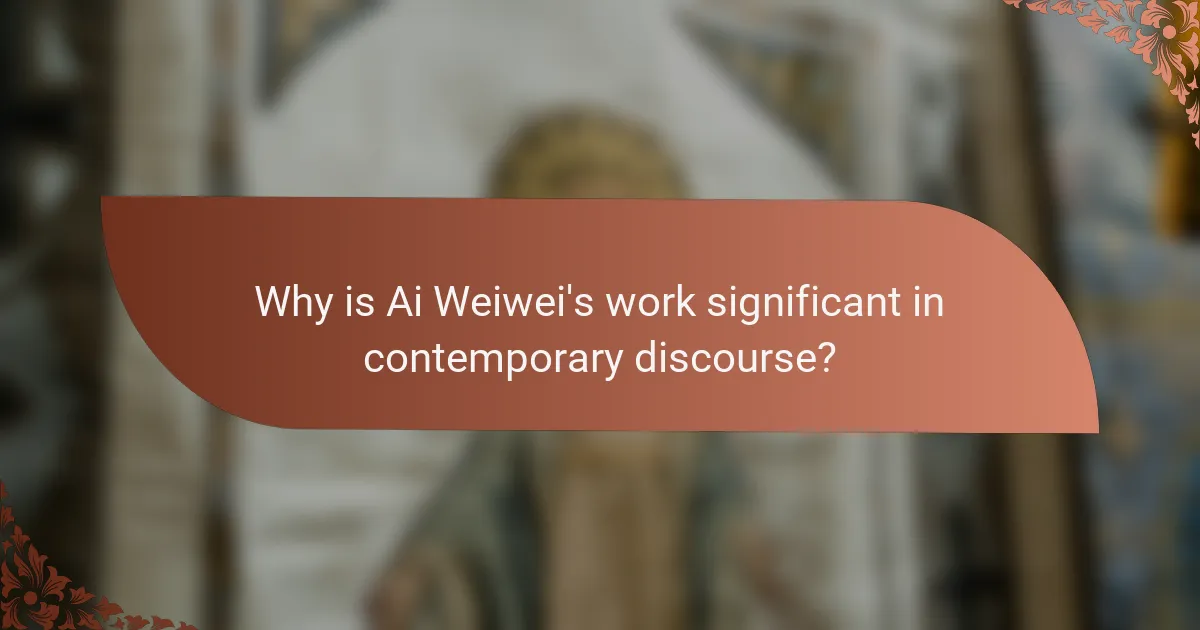
Why is Ai Weiwei’s work significant in contemporary discourse?
Ai Weiwei’s work is significant in contemporary discourse due to its intersection of art and activism. His projects address human rights, freedom of expression, and social justice, making powerful statements against oppression. For example, his installation “Sunflower Seeds” critiques mass consumption and individualism, reflecting on cultural and political issues. Ai’s unique ability to blend traditional Chinese art with modern concepts enhances his relevance, engaging audiences globally. His activism challenges societal norms and inspires dialogue, positioning him as a pivotal figure in contemporary art and social movements.
How does Ai Weiwei challenge political norms through his art?
Ai Weiwei challenges political norms through provocative art that critiques government actions and human rights abuses. His installations often blend traditional and contemporary mediums, making complex political issues accessible. For example, his work “Sunflower Seeds” symbolizes mass production and the loss of individuality in China. This unique approach fosters dialogue about freedom and censorship, making his art relevant in contemporary activism. Ai’s commitment to social justice and expression continues to inspire global audiences, reinforcing his role as a leading figure in political art today.
What impact does Ai Weiwei have on global human rights conversations?
Ai Weiwei significantly influences global human rights conversations through his art and activism. His works challenge authoritarianism and promote freedom of expression. By using various mediums, including installations and social media, he raises awareness of human rights abuses worldwide. His unique perspective as a dissident artist amplifies marginalized voices, fostering dialogue on pressing issues. Ai’s commitment to activism has inspired movements, making him a pivotal figure in contemporary discussions on human rights.
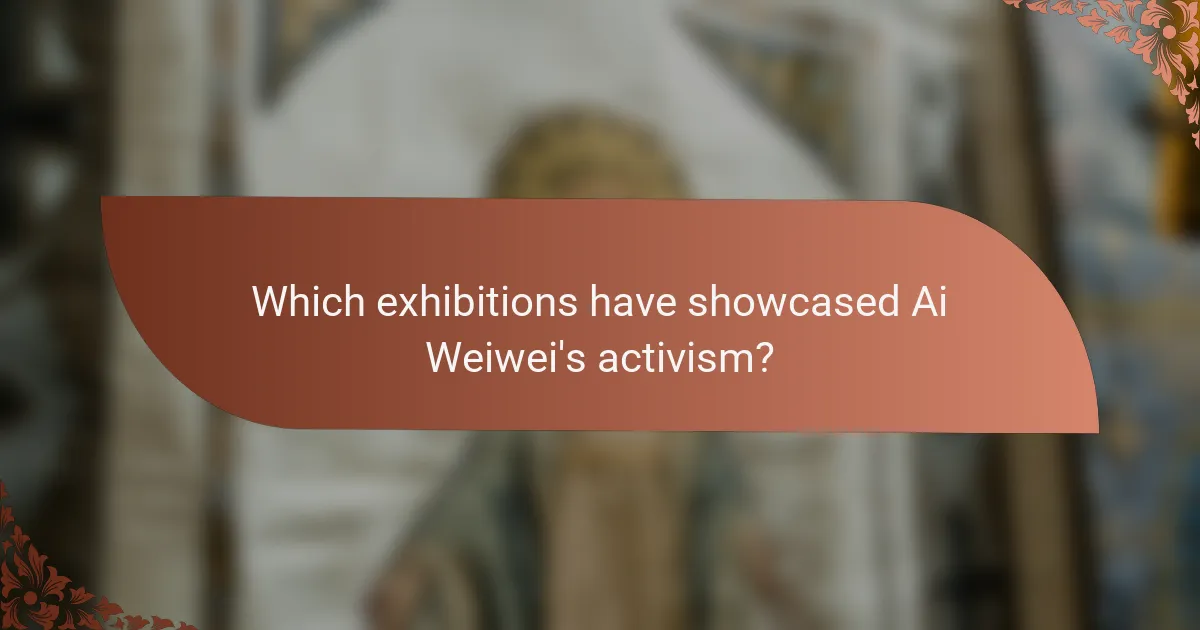
Which exhibitions have showcased Ai Weiwei’s activism?
Ai Weiwei’s activism has been showcased in several notable exhibitions worldwide. Key exhibitions include “Ai Weiwei: According to What?” at the Hirshhorn Museum, which explored his political commentary and artistic mediums. “Sunflower Seeds” at the Tate Modern highlighted themes of mass production and individualism. The “Good Fences Make Good Neighbors” installation in New York City addressed immigration and borders. Additionally, “Ai Weiwei: Trace” at Alcatraz drew attention to human rights issues, emphasizing his unique ability to merge art with activism.
What are the most notable installations by Ai Weiwei?
Ai Weiwei’s most notable installations include “Sunflower Seeds,” “Remembering,” and “Straight.” These works reflect his activism and critique of social issues.
“Sunflower Seeds” features millions of handcrafted porcelain seeds, symbolizing mass production and individuality. “Remembering” commemorates the Sichuan earthquake victims with 9,000 children’s backpacks. “Straight” transforms rebar from earthquake sites into a powerful statement on corruption and loss.
These installations showcase Ai Weiwei’s unique ability to merge art with political commentary, emphasizing contemporary relevance.
How have different regions responded to Ai Weiwei’s exhibitions?
Different regions have responded to Ai Weiwei’s exhibitions with a mix of admiration, controversy, and political discourse. In Europe, his work often sparks dialogue on human rights and freedom of expression. In Asia, reactions can vary significantly, with some exhibitions facing censorship while others receive acclaim. In North America, his installations frequently engage audiences on social issues, reflecting contemporary relevance. Each region’s response highlights unique cultural contexts and political climates, shaping the impact of his activism and mediums.
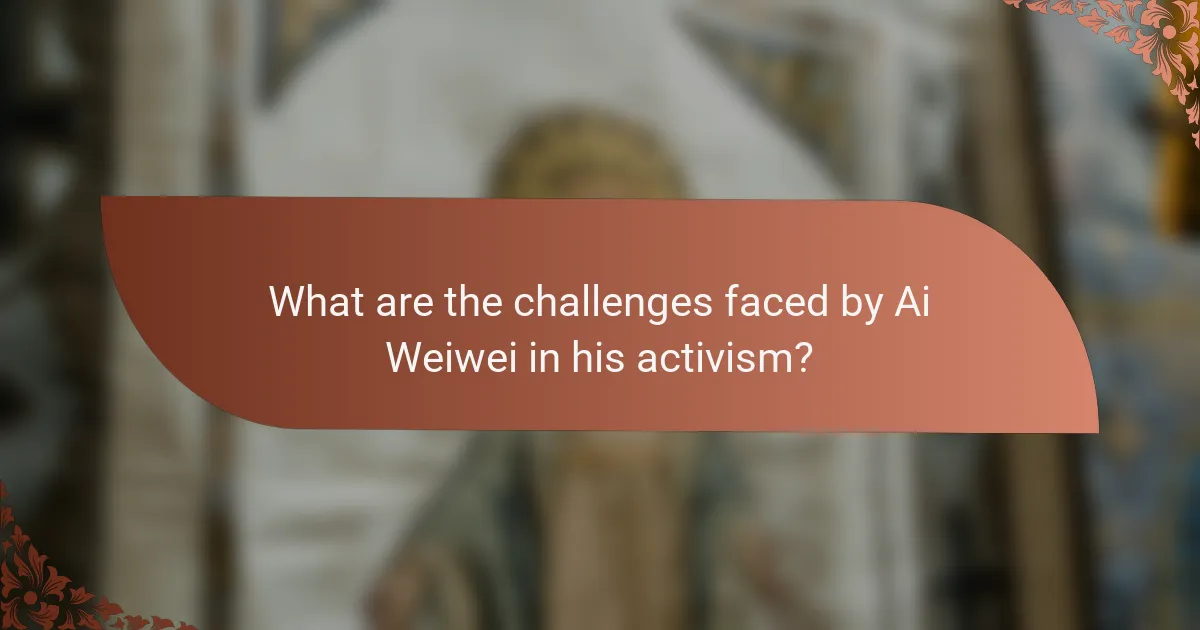
What are the challenges faced by Ai Weiwei in his activism?
Ai Weiwei faces significant challenges in his activism, including government censorship, threats to personal safety, and limited access to resources. His outspoken criticism of the Chinese government often results in surveillance and harassment. Additionally, navigating the complexities of international art politics complicates his efforts to raise awareness. The unique attribute of his activism lies in the blend of art and political commentary, which can alienate some audiences while inspiring others.
How does censorship affect Ai Weiwei’s work?
Censorship significantly impacts Ai Weiwei’s work by limiting his freedom of expression and altering his message. It forces him to adapt his mediums, often using subtlety or irony to convey dissent. Censorship shapes his artistic approach, making his work a commentary on repression. As a result, his pieces often reflect the struggle against authoritarian control, enhancing their contemporary relevance.
What legal battles has Ai Weiwei encountered?
Ai Weiwei has faced numerous legal battles primarily due to his activism against the Chinese government. Notable instances include his 2011 detention for 81 days, which drew international condemnation. He has also encountered issues related to tax evasion charges, which he claims were politically motivated. His outspoken criticism of government policies has led to ongoing harassment and restrictions on his movement. Additionally, Ai has engaged in legal actions to reclaim his artworks and protect his intellectual property against state interference.
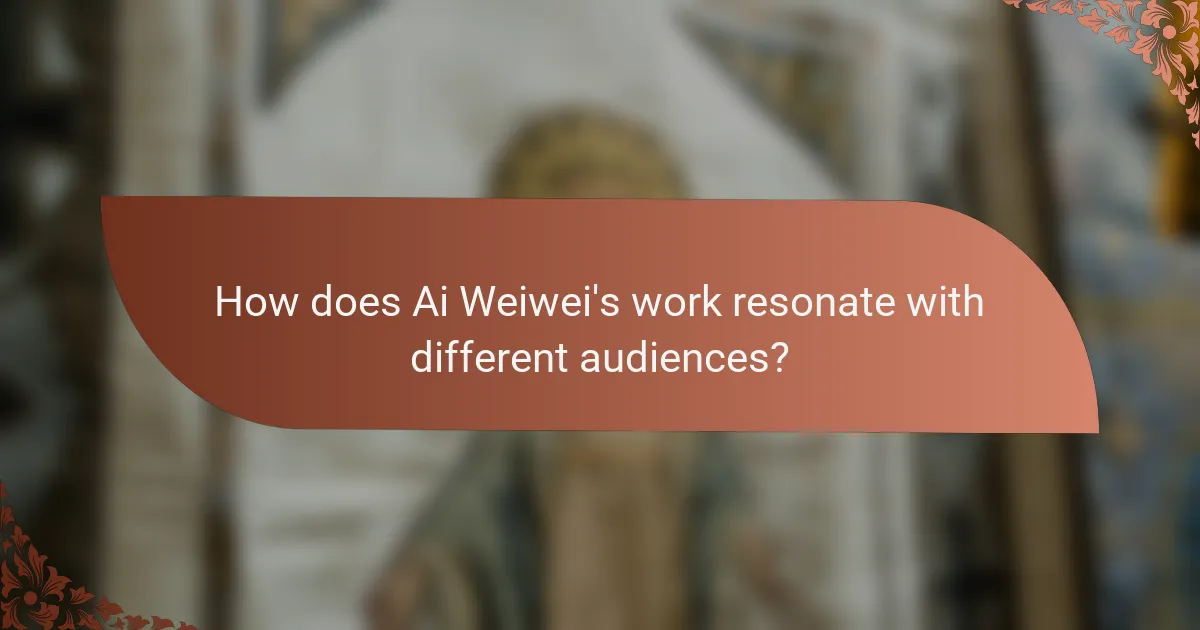
How does Ai Weiwei’s work resonate with different audiences?
Ai Weiwei’s work resonates with diverse audiences through its powerful commentary on human rights and freedom. His use of various mediums, including sculpture, installation, and social media, engages people from different backgrounds. For example, his installations often provoke emotional responses, while his activism highlights pressing social issues. This multifaceted approach allows his art to transcend cultural boundaries and connect with individuals on personal and political levels. Additionally, his unique ability to blend traditional Chinese art with contemporary themes appeals to both local and global audiences, making his work relevant across various contexts.
What are the reactions of art critics to Ai Weiwei’s activism?
Art critics have largely praised Ai Weiwei’s activism for its boldness and relevance. They recognize his ability to address pressing social issues through various mediums, including installation art and social media. Critics often highlight his unique approach, which combines personal narrative with broader political commentary. Some argue that his work effectively challenges authoritarianism, while others appreciate his capacity to engage the public in dialogue. Overall, Ai Weiwei’s activism is seen as a vital contribution to contemporary art and social discourse.
How do various cultural contexts shape the interpretation of his art?
Cultural contexts significantly influence the interpretation of Ai Weiwei’s art. Different societies perceive his activism and mediums through unique lenses shaped by historical, political, and social factors. For instance, in Western contexts, his work often emphasizes freedom of expression and human rights, while in Chinese contexts, it may reflect a critique of government censorship and cultural identity. This duality highlights the root attribute of his art: its capacity to provoke thought across diverse audiences. Unique interpretations arise from local cultural narratives, which can either resonate with or challenge his themes. As a result, Ai Weiwei’s art serves as a powerful dialogue tool, bridging cultural divides and fostering global conversations.
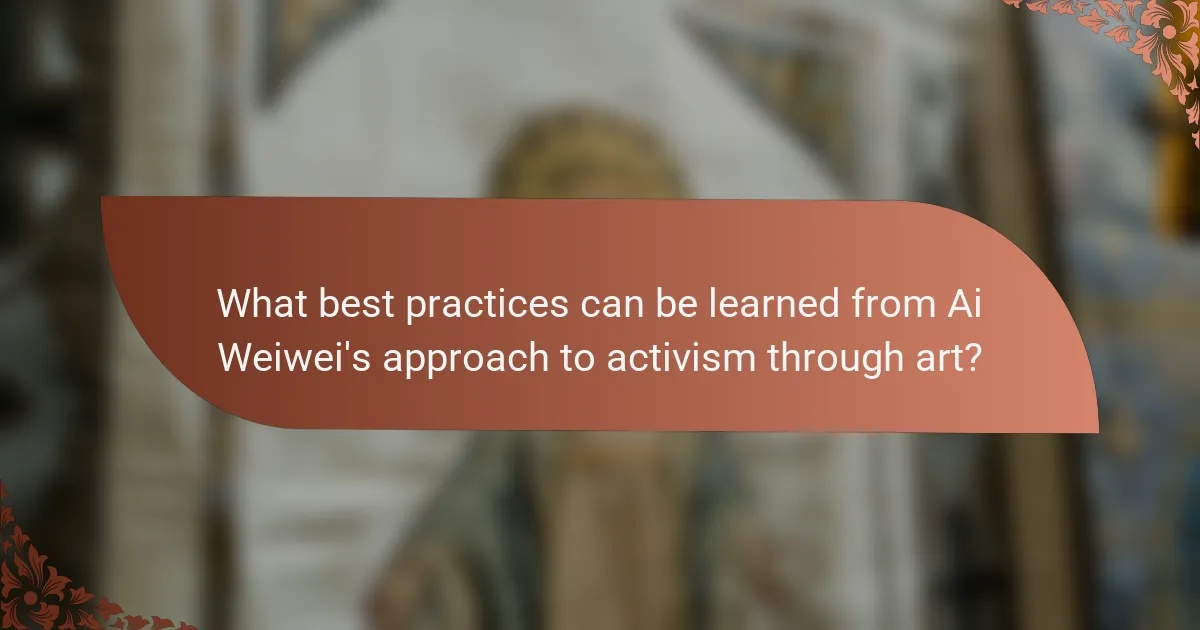
What best practices can be learned from Ai Weiwei’s approach to activism through art?
Ai Weiwei’s approach to activism through art emphasizes engagement, accessibility, and social critique. He utilizes various mediums to challenge authority and provoke dialogue.
Key best practices include using art to raise awareness about social issues, fostering collaboration with diverse communities, and leveraging digital platforms for broader reach. Weiwei’s unique ability to blend personal narrative with universal themes resonates widely, making his activism relatable and impactful.
Additionally, his willingness to confront political power directly showcases the importance of courage in activism. By integrating personal experiences with global issues, he creates a compelling narrative that inspires others.
Which strategies can artists adopt from Ai Weiwei’s methods?
Artists can adopt strategies from Ai Weiwei’s methods by embracing activism, utilizing diverse mediums, and engaging with contemporary issues. His approach emphasizes the importance of social commentary and cultural critique.
Collaboration is key; artists should seek partnerships across disciplines to amplify their messages. Weiwei’s use of traditional and modern techniques highlights the value of innovation in artistic expression.
Engagement with audiences is crucial; artists should create interactive experiences that provoke thought and dialogue. Weiwei’s work often invites public participation, fostering a sense of community and shared responsibility.
Lastly, artists should remain resilient in the face of adversity, as Weiwei exemplifies courage in challenging oppressive systems. This commitment to advocacy can inspire a powerful impact on society.
What common mistakes should artists avoid when engaging in activism?
Artists should avoid being overly self-promotional, neglecting research, ignoring their audience, and failing to collaborate. These mistakes can undermine the impact of their activism.
Overemphasis on personal brand can detract from the message. Conducting thorough research ensures informed activism and credibility. Understanding the audience fosters connection and engagement. Collaborating with others amplifies voices and enhances effectiveness.
By focusing on these areas, artists can strengthen their activism and create meaningful change.
